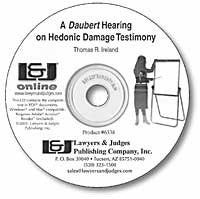
Eyewitness Reliability in Motor Vehicle Crashes: A Primer for Practitioners 2nd edition
- Author: Patrick J. Robins
- ISBN 10: 1-933264-68-3
- ISBN 13: 978-1-933264-68-4
- Copyright Date Ed: August 1, 2009
- Pages: 104 pages
- Binding Information: Paperback
-
Size: 6 ✕ 9 Inches (US)
A necessity for anyone involved with eyewitness reports.
Eyewitnesses, especially in testimony, can be a mess. Two witnesses can contradict one another over the same accident scene. Some acquire post-event misinformation. And human memory, always unreliable, plays a crucial role. Now you can be prepared with this book, exploring all the fallible aspects of eyewitness testimony. You will learn how a jury evaluates eyewitness testimony on the basis of witness confidence and personality. This book teaches you to counteract this by knowing what questions to ask your witnesses to get the most accurate information, where to undermine the eyewitness testimony against you, and how to avoid the pitfalls of eyewitness evidence. Dr. Robins cites case studies, research, and seminar demonstrations that are both interesting and educational. By learning from one of the world's experts, you will make eyewitness testimony an asset to your case.
This book is also available as an eBook. Click here to purchase and download:
Topics Include:
- Use of physical evidence
- Limitations of physical evidence
- Use of human evidence
- Limitations of human evidence
- Evidence and truth
- Vision
- Sensation
- Perception
- Central viewing
- Peripheral viewing
- Contrast
- Attention
- Perception of distance and speed
- Processing speed and time
- Perception of time
- Perception and knowledge
- Perception and expectation
- Perception and truth
- Sensory memory
- Short-Term memory
- Long-Term memory
- Memory distortion
- Memory and emotion
- Sources of misinformation
- Witness overconfidence
- Forgetting in sensory short-term and long-term memory
- Cue-Dependent forgetting
- State-Dependent forgetting
- Amnesia
- The scientific model
- Internal and external validity
- The role of chance
- Statistical significance versus usefulness
- Human factors issues
- Practical considerations
Table of Contents
Preface
Chapter 1. Physical Evidence versus Human Evidence: What’s the Big Deal Here Anyway?
1.1 Making Use of Physical Evidence
1.2 Limitations of Physical Evidence
1.3 Making Use of Human Evidence
1.4 Limitations of Human Evidence
1.5 Evidence and Truth
1.6 The Frailty of Human Evidence
Chapter 2. How We Process the World Around Us: What You See Is Not Necessarily What You Get
2.1 Sensation
2.2 How We See Anything
2.3 The Structure of the Eye
2.4 Central Viewing versus Peripheral Viewing
2.5 The Role of Contrast
2.6 The Role of Attention
2.7 Day versus Night
2.8 Adapting to Changing Light Conditions
2.9 Illuminance, Luminance and Things That Go Bump In the Night
2.10 Sensation versus Perception
2.11 When Perception Fails
2.12 Perception of Distance and Speed
2.13 Processing Speed and Time
2.14 Perception of Time
2.15 Perception and Knowledge
2.16 Perception and Expectation
2.17 Perception and Truth
Chapter 3. Human Memory: I Have a Pretty Good Memory; It’s Just a Little Short
3.1 The Nature of Memory
3.2 Sensory Memory
3.3 Short-Term Memory
3.4 Long-Term Memory
3.5 Memory Distortion
3.6 Sources of Misinformation in the Real World
3.7 Witness Overconfidence
3.8 Memory and Emotion
Chapter 4. Forgetting: Forgotten but Not Lost?
4.1 Forgetting in Sensory Memory and Short-Term Memory
4.2 Forgetting in Long-Term Memory
4.3 Cue-Dependent Forgetting
4.4 State-Dependent Forgetting
4.5 Interference
4.6 Amnesia
Chapter 5. Good Science: From the Ivory Tower to the Real World
5.1 The Scientific Model
5.2 Internal Validity
5.3 Control
5.4 The Role of Chance
5.5 Statistical Significance versus Usefulness
5.6 External Validity
Chapter 6. Some Practical Considerations: Pick Me Up and Dust Me Off
6.1 What We See and Hear Are Products of Our Minds, Not of Our Eyes and Ears
6.2 People Are Very Poor Judges of Vehicle Distances and Speeds
6.3 Eyewitnesses Consistently Overestimate the Time Duration of Events
6.4 The Phrase "I Don’t Remember" May Mean Different Things for Different Witnesses
6.5 Human Memory Is Not like a Recording Device
6.6 Memory Is Autobiographical in Nature
6.7 Memory Is Not Stable Over Time
6.8 Our Memories Can Become Distorted
6.9 People Are Overconfident in Their Recollections
6.10 The Legal System Places More Trust in Eyewitness Evidence Than Is Justified
6.11 Emotion Facilitates Improved Memory for Central Events but Poorer Memory for Peripheral Events
6.12 Some Concluding Remarks
References
About the Author
Index




